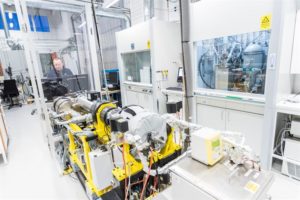Wärtsilä Tests Internal Combustion of Ammonia
By Stephen H. Crolius on April 02, 2020
Last week Wärtsilä, the Finnish engine and energy equipment manufacturer, unveiled the latest stage in its engagement with ammonia as an energy vector. In a press release headlined “Wärtsilä advances future fuel capabilities with first ammonia tests,” the company described a test program aimed at exploring ammonia’s properties as an internal combustion fuel. Kaj Portin, General Manager of Fuel & Operational Flexibility in Wärtsilä’s Marine division, commented that “the first tests have yielded promising results.”
Wärtsilä, whose origins as an industrial concern go back to the nineteenth century, is organized today into Marine and Energy business units. According to its Web site, Wärtsilä in total had net sales of €5.2 billion (USD $5.7 billion) in 2019. The company takes a systems-oriented approach in both divisions, supplying engines and other discrete components, but also providing a range of additional hardware and software products that can contribute to complete customer solutions.
According to the press release, Wärtsilä first applied its systems approach on behalf of ammonia in the design of “cargo handling systems for liquid petroleum gas carriers, many of which are used to transport ammonia.” This experience provided the foundation for the company’s role in two recent ammonia energy initiatives. In the first, announced in June 2019, Wärtsilä is taking the lead in the Zero Emission Energy Distribution at Sea initiative. As described in Ammonia Energy, the mission of the multi-company ZEEDS coalition is to produce and distribute low-carbon maritime fuels, including ammonia, from facilities purpose-built in the waters off northern Europe.
The second initiative, announced in February 2020, will demonstrate operation of a North Sea supply vessel powered by a solid oxide fuel cell with ammonia as a fuel. In this project Wärtsilä “will be responsible for power technology and ammonia storage and distribution systems,” in the words of an Ammonia Energy article.
The Wärtsilä press release is clear that the company’s overall goal is to “develop a complete ammonia fuel solution comprising engines, fuel supply and storage.” The press release continues, “the company is working with ship owners, shipbuilders, classification societies and fuel suppliers to learn more about system and safety requirements, as well as fuel composition, emissions and efficiency.”

In the press release’s description, Wärtsilä’s research is currently focused on burning ammonia in a “combustion research unit” with the goal of better understanding ammonia’s combustion properties. In a subsequent phase, Wärtsilä will continue the research using both “dual-fuel and spark-ignited gas engines.” Thereafter, field tests will be conducted “in collaboration with ship owners from 2022.”
The press release says that Wärtsilä is “investigating several future fuels, including synthetic methane, ammonia, hydrogen and methanol, with a view to providing complete flexibility across engines and the fuel chain.” The goal, according to Portin, is to ensure that “Wärtsilä can provide the engine and fuel systems that ship owners need, whichever fuel they choose in the future.” The goal will be served by Wärtsilä’s “extensive experience in converting engines to other fuels, including diesel to dual-fuel, as well as engines capable of burning methanol and volatile organic compounds from crude oil cargoes,” not to mention the “modularity of modern engines [which] means that conversions can be made with a very limited exchange of components.”
With Wärtsilä’s focus on the maritime sector, it is easy to overlook one more important takeaway from the press release: the company also has its sights set on the energy sector as a market for ammonia technology. It sees ammonia as a fuel that can reduce the energy sector’s greenhouse gas emissions, and will “potentially” explore ammonia options “with energy customers in the future.”